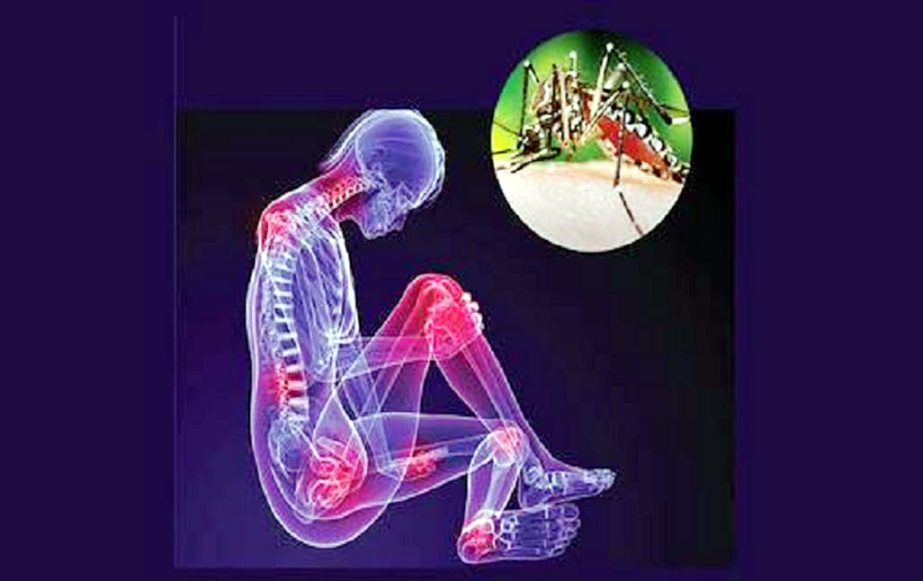
Shafika Riffat Kaniz :
An unprecedented outbreak of the Chikungunya virus continues to affect the dwellers of Dhaka city. The disease, which causes fever along with severe, often disabling joint pain, leaves its victims bedridden for days. Although there is no specific treatment regimens for Chikungunya , treatment is directed primarily at relieving the symptoms. No vaccine for the bug is commercially available.
Chikungunya is a mosquito-borne viral disease. The causative organism is transmitted from human to human by the bites of infected female mosquitoes. Most commonly, the mosquitoes involved are Aedes aegypti and Aedes albopictus , two species which can also transmit other mosquito-borne viruses, including dengue. The proximity of mosquito breeding sites to human habitation is a significant risk factor for Chikungunya. After being bitten by an infected mosquito, the onset of the illness occurs usually between 4 to 8 days.
The disease manifests some clinical features which include abrupt onset of fever associated with joint pain, mostly involving arms and legs. Other common signs and symptoms are body rashes, muscle pain, headache, nausea and fatigue. The joint pain is often very debilitating, but usually lasts for a few days or may be prolonged to weeks. Most patients recover fully, but in some cases joint pain may persist for months. Serious complications are not common, but in older people, the disease can contribute to the cause of death. Laboratory diagnosis is generally accomplished by testing serum or plasma. Enzyme-linked immunosorbent assays (ELISA), may confirm the presence of IgM and IgG anti-chikungunya antibodies. IgM antibody levels are highest 3 to 5 days after the onset of illness and persist for about 2 months. Viral cultural may detect virus in the first 3 days of illness. Various RT-PCR methods are also available but are of variable sensitivity.
There is no specific treatment for Chikungunya, but anti-pyretic, analgesics and non-steroidal anti-inflammatory medication may be used to reduce the pain and fever.
There is no commercial chikungunya vaccine, hence preventive measures depends entirely on avoiding mosquito bites which occur mainly during the daytime, and eliminating mosquito breeding sites. Basic precautions, which should be taken by people, include wearing clothes that covers as much skin as possible, applying mosquito repellants onto exposed skin, using mosquito nets to protect babies, older and sick people and others who rest during the day; using mosquito coils and insecticide vaporizers during the daytime and ensuring rooms are fitted with screens to prevent mosquitoes from entering. Environmental hygiene is to be maintained, with a view to combating the disease. Artificial water-filled containers which are common around human dwellings and workplaces, for example water storage containers, saucers under potted plants and drinking bowls for domestic animals, as well as discarded tyres and food containers should be removed.
(The writer has appeared for Final Professional M.B.B.S examinations, HF-13, Holy Family Red Crescent Medical College And Hospital, Dhaka)
An unprecedented outbreak of the Chikungunya virus continues to affect the dwellers of Dhaka city. The disease, which causes fever along with severe, often disabling joint pain, leaves its victims bedridden for days. Although there is no specific treatment regimens for Chikungunya , treatment is directed primarily at relieving the symptoms. No vaccine for the bug is commercially available.
Chikungunya is a mosquito-borne viral disease. The causative organism is transmitted from human to human by the bites of infected female mosquitoes. Most commonly, the mosquitoes involved are Aedes aegypti and Aedes albopictus , two species which can also transmit other mosquito-borne viruses, including dengue. The proximity of mosquito breeding sites to human habitation is a significant risk factor for Chikungunya. After being bitten by an infected mosquito, the onset of the illness occurs usually between 4 to 8 days.
The disease manifests some clinical features which include abrupt onset of fever associated with joint pain, mostly involving arms and legs. Other common signs and symptoms are body rashes, muscle pain, headache, nausea and fatigue. The joint pain is often very debilitating, but usually lasts for a few days or may be prolonged to weeks. Most patients recover fully, but in some cases joint pain may persist for months. Serious complications are not common, but in older people, the disease can contribute to the cause of death. Laboratory diagnosis is generally accomplished by testing serum or plasma. Enzyme-linked immunosorbent assays (ELISA), may confirm the presence of IgM and IgG anti-chikungunya antibodies. IgM antibody levels are highest 3 to 5 days after the onset of illness and persist for about 2 months. Viral cultural may detect virus in the first 3 days of illness. Various RT-PCR methods are also available but are of variable sensitivity.
There is no specific treatment for Chikungunya, but anti-pyretic, analgesics and non-steroidal anti-inflammatory medication may be used to reduce the pain and fever.
There is no commercial chikungunya vaccine, hence preventive measures depends entirely on avoiding mosquito bites which occur mainly during the daytime, and eliminating mosquito breeding sites. Basic precautions, which should be taken by people, include wearing clothes that covers as much skin as possible, applying mosquito repellants onto exposed skin, using mosquito nets to protect babies, older and sick people and others who rest during the day; using mosquito coils and insecticide vaporizers during the daytime and ensuring rooms are fitted with screens to prevent mosquitoes from entering. Environmental hygiene is to be maintained, with a view to combating the disease. Artificial water-filled containers which are common around human dwellings and workplaces, for example water storage containers, saucers under potted plants and drinking bowls for domestic animals, as well as discarded tyres and food containers should be removed.
(The writer has appeared for Final Professional M.B.B.S examinations, HF-13, Holy Family Red Crescent Medical College And Hospital, Dhaka)

